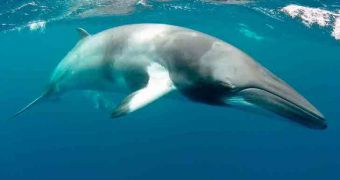Researchers writing in yesterday's issue of the journal Biology Letters claim to have solved the mystery surrounding an odd oceanic sound whose origin has eluded the scientific community for decades.
The sound in question was first heard by submarine crews back in the 1960s, in the waters around Antarctica. At that time, it was described as a duck-like sound, meaning that it comprised series of low-pitched pulsing sounds.
In time, the sound came to be referred to as an oceanic quack. However, despite researchers' best efforts, its origin remained unknown. Until marine biologist Denise Risch and her colleagues came along, that is.
Not to keep you in suspense, it turns that this duck-like sound documented in the ocean around Antarctica is not the work of Cthulhu. On the contrary, Denise Risch and her fellow researchers have reasons to believe that the creatures producing it are minke whales swimming in these waters. Live Science informs that, back in 2013, the marine biologist and her colleagues tagged two Antarctic minke whales. Their goal was to collect information concerning these animals' feeding behavior and their movements through the ocean.
Due to the fact that the suction-cup tags that the researchers used to keep tabs on the two minke whales were also fitted with microphones, the scientists were able to eavesdrop on what the marine mammals were chatting about while busy swimming.
While analyzing the acoustic recording obtained in this manner, Denise Risch and her fellow researchers came across the peculiar oceanic quack and concluded that the marine mammals were its source. “[The sounds] can now be attributed unequivocally to the Antarctic minke whale,” they say.
For the time being, specialists are unable to say why it is that this species of marine mammals emits this series of repetitive, low-pitched pulsing sounds. All things considered, it is likely that minke whales rely on these sounds either for navigation or for breeding.
What's more, scientists are at a loss for words when it comes to explaining whether both male and female minke whales produce these sounds. Hopefully, further investigations will help shed more light on the issue.
Now that the source of the peculiar oceanic quack first heard in the 1960s has been determined, specialists expect that they can use this information to keep tabs on the world's minke whale population. Thus, it should be possible to determine what these marine mammals are up to by documenting occurrences of the duck-like sounds they are now known to produce.

 14 DAY TRIAL //
14 DAY TRIAL //